初一英语教案人教版Unit13
初中七年级英语 全册 Unit1-12 教案+说课稿 人教新目标版(付,222页)
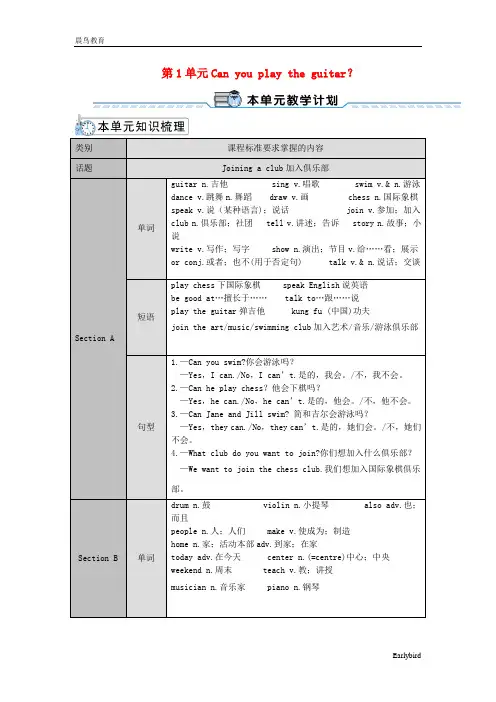
第1单元Can you play the guitar?类别课程标准要求掌握的内容话题Joining a club加入俱乐部Section A 单词guitar n.吉他 sing v.唱歌 swim v.& n.游泳dance v.跳舞n.舞蹈 draw v.画 chess n.国际象棋speak v.说(某种语言);说话 join v.参加;加入club n.俱乐部;社团 tell v.讲述;告诉 story n.故事;小说write v.写作;写字 show n.演出;节目v.给……看;展示or conj.或者;也不(用于否定句) talk v.& n.说话;交谈短语play chess下国际象棋 speak English说英语be good at…擅长于……talk to…跟……说play the guitar弹吉他 kung fu (中国)功夫join the art/music/swimming club加入艺术/音乐/游泳俱乐部句型1.—Can you swim?你会游泳吗?—Yes,I can./No,I can’t.是的,我会。
/不,我不会。
2.—Can he play chess?他会下棋吗?—Yes,he can./No,he can’t.是的,他会。
/不,他不会。
3.—Can Jane and Jill swim? 简和吉尔会游泳吗?—Yes,they can./No,they can’t.是的,她们会。
/不,她们不会。
4.—What club do you want to join?你们想加入什么俱乐部?—We want to join the chess club.我们想加入国际象棋俱乐部。
Section B 单词drum n.鼓 violin n.小提琴 also adv.也;而且people n.人;人们 make v.使成为;制造home n.家;活动本部adv.到家;在家today adv.在今天 center n.(=centre)中心;中央weekend n.周末 teach v.教;讲授musician n.音乐家 piano n.钢琴短语play the piano/violin/drums 弹钢琴/拉小提琴 /打鼓be good with…善于应付……的;对……有办法make friends交朋友help (sb.) with sth.在某方面帮助(某人)on the weekend (在)周末句型1. I like to play basketball.我喜欢打篮球。
七年级L13L14L15L16教案
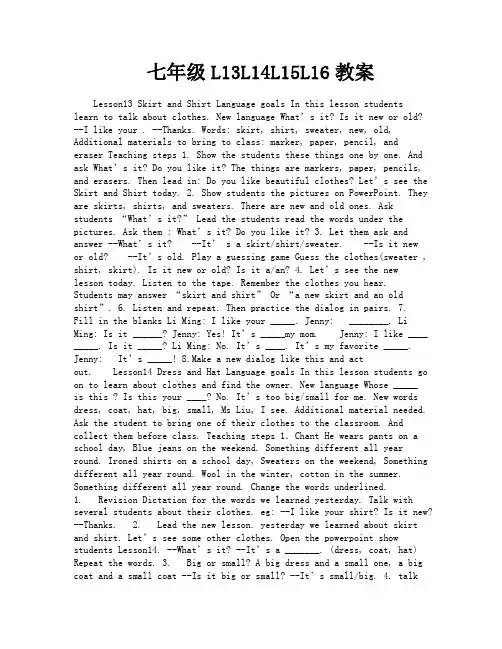
七年级L13L14L15L16教案Lesson13 Skirt and Shirt Language goals In this lesson studentslearn to talk about clothes. New language What’s it? Is it new or old? --I like your . --Thanks. Words: skirt, shirt, sweater, new, old, Additional materials to bring to class: marker, paper, pencil, anderaser Teaching steps 1. Show the students these things one by one. And ask What’s it? Do you like it? The things are markers, paper, pencils, and erasers. Then lead in: Do you like beautiful clothes? Let’s see the Skirt and Shirt today. 2. Show students the pictures on PowerPoint. They are skirts, shirts, and sweaters. There are new and old ones. Ask students “What’s it?” Lead the students read the words under the pictures. Ask them : What’s it? Do you like it? 3. Let them ask and answer --What’s it? --It’ s a skirt/shirt/sweater. --Is it newor old? --It’s old. Play a guessing game Guess the clothes(sweater , shirt, skirt). Is it new or old? Is it a/an? 4. Let’s see the newlesson today. Listen to the tape. Remember the clothes you hear.Students may answer “skirt and shirt” Or “a new skirt and an old shirt”. 6. Listen and repeat. Then practice the dialog in pairs. 7.Fill in the blanks Li Ming: I like your _____. Jenny: ________. Li Ming: Is it ______? Jenny: Yes! It’s _____my mom. Jenny: I like ____ _____. Is it _____? Li Ming: No. It’s ____. It’s my favorite _____. Jenny: It’s _____! 8.Make a new dialog like this and actout. Lesson14 Dress and Hat Language goals In this lesson students go on to learn about clothes and find the owner. New language Whose _____is this ? Is this your ____? No. It’s too big/small for me. New words dress, coat, hat, big, small, Ms Liu, I see. Additional material needed. Ask the student to bring one of their clothes to the classroom. And collect them before class. Teaching steps 1.Chant He wears pants on a school day, Blue jeans on the weekend. Something different all year round. Ironed shirts on a school day, Sweaters on the weekend, Something different all year round. Wool in the winter, cotton in the summer. Something different all year round. Change the words underlined.1. Revision Dictation for the words we learned yesterday. Talk with several students about their clothes. eg: --I like your shirt? Is it new? --Thanks.2. Lead the new lesson. yesterday we learned about skirt and shirt. Let’s see some other clothes. Open the powerpoint show students Lesson14. --What’s it? --It’s a _______. (dress, coat, hat) Repeat the words.3. Big or small? A big dress and a small one, a big coat and a small coat --Is it big or small? --It’s small/big.4. talkabout the things whether they are big or small. For example,clothes, schoolbag, classroom, playground 5. Teacher takes out one of the clothes that have prepared. Ask whose _____is this ? Is thisyour____? Now let’s see what Ms Liu found? And whose is it? Listen to the tape. And answer the two questions. Ms Liu found a hat, a dress and a coat. We don’t know whose they are. 6. Listen again and repeat. And act out one of the three dialogs. 7. Fill in the blanks. Ms Liu: Whose ______is this? Is this your ______, Danny? Danny: No, Ms Liu. It’s too_____ for me. Ms Liu: Whose _____is this? Is this _____ _____, Danny? Danny: _____! It’s ______ ______ for me. Ms Liu: Yes, Danny. I see. Ms Liu:_______ _______is this? Is this____ ____, Jenny? Jenny: No! It’s too_____ _____ _____. 8. Activity Find the owner. Whose ______is this? Is this your______? 9. Read the chant again as the end of the lesson. Lesson 15 Shorts, Pants, Shoes, Socks [教学目标] 1 学习衣服名称:shorts,pants, shoes, socks 2 学习使用量词:a pair of 3 掌握单词: shirt, skirt, what, new, old, like, no 4 掌握句型:Myfavourite clothes are. [教学难点] a pair of [教学重点] 学习表达我最喜爱的',熟练掌握My favourite clothes are Do you like? Yes, I do. /No, I don’t. [教具] 多媒体计算机。
人教版新目标英语七年级上册教案第13单元(写写帮推荐)
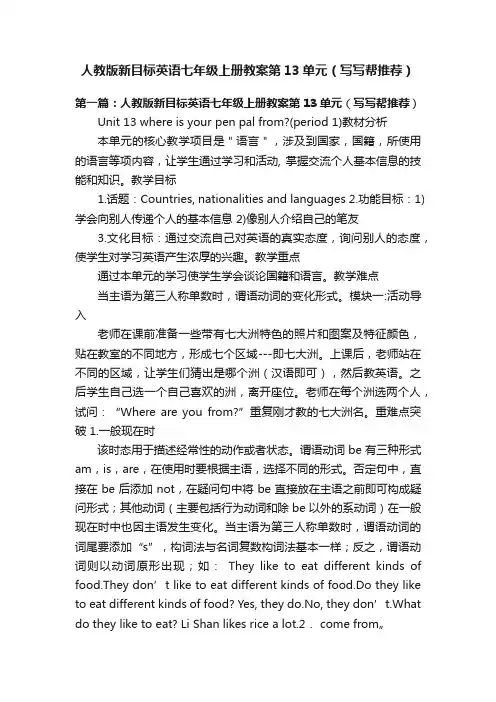
人教版新目标英语七年级上册教案第13单元(写写帮推荐)第一篇:人教版新目标英语七年级上册教案第13单元(写写帮推荐)Unit 13 where is your pen pal from?(period 1)教材分析本单元的核心教学项目是"语言",涉及到国家,国籍,所使用的语言等项内容,让学生通过学习和活动, 掌握交流个人基本信息的技能和知识。
教学目标1.话题:Countries, nationalities and languages2.功能目标:1)学会向别人传递个人的基本信息 2)像别人介绍自己的笔友3.文化目标:通过交流自己对英语的真实态度,询问别人的态度,使学生对学习英语产生浓厚的兴趣。
教学重点通过本单元的学习使学生学会谈论国籍和语言。
教学难点当主语为第三人称单数时,谓语动词的变化形式。
模块一:活动导入老师在课前准备一些带有七大洲特色的照片和图案及特征颜色,贴在教室的不同地方,形成七个区域---即七大洲。
上课后,老师站在不同的区域,让学生们猜出是哪个洲(汉语即可),然后教英语。
之后学生自己选一个自己喜欢的洲,离开座位。
老师在每个洲选两个人,试问:“Where are you from?”重复刚才教的七大洲名。
重难点突破 1.一般现在时该时态用于描述经常性的动作或者状态。
谓语动词be有三种形式am,is,are,在使用时要根据主语,选择不同的形式。
否定句中,直接在be后添加not,在疑问句中将be直接放在主语之前即可构成疑问形式;其他动词(主要包括行为动词和除be以外的系动词)在一般现在时中也因主语发生变化。
当主语为第三人称单数时,谓语动词的词尾要添加“s”,构词法与名词复数构词法基本一样;反之,谓语动词则以动词原形出现;如:They like to eat different kinds of food.They don’t like to eat different kinds of food.Do they like to eat different kinds of food? Yes, they do.No, they don’t.What do they like to eat? Li Shan likes rice a lot.2.come from…来自于”,但是它们在句中的使用方式是不同的。
StarterUnit13课时教案人教版英语七年级上册

若羌县中学集体备课(初备)教案
若羌县中学集体备课(初备)教案
若羌县中学集体备课(初备)教案
当堂训练Ⅷ. Practice
1. Tell Ss to look at the picture in 2d. First, read the letters aloud. Then let some Ss read the letters to the class aloud.
2. Let Ss try to write down the missing letters. Check the answers with your partner.
3. Let some Ss e the Bb and write missing letters on the Bb.
Ⅸ. Read and Talk
1. Let Ss look at the pictures in 2e. Let some Ss read the letters below each picture.
2. Let some Ss talk about the meaning of each picture.
作业设计
1、课下练习用英语询问你知道的事物的名称。
2、背诵字母Ii到Rr。
板书设计
教学反思
若羌县中学集体备课(初备)教案
若羌县中学集体备课(初备)教案
若羌县中学集体备课(初备)教案
若羌县中学集体备课(初备)教案。
(整理)初一英语教案人教版Unit13
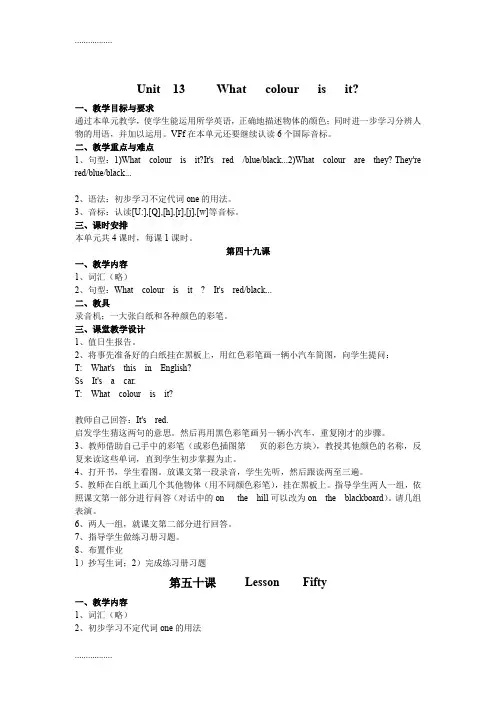
Unit 13 What colour is it?一、教学目标与要求通过本单元教学,使学生能运用所学英语,正确地描述物体的颜色;同时进一步学习分辨人物的用语,并加以运用。
VFf在本单元还要继续认读6个国际音标。
二、教学重点与难点1、句型:1)What colour is it?It's red /blue/black...2)What colour are they? They're red/blue/black...2、语法:初步学习不定代词one的用法。
3、音标:认读[U:],[Q],[h],[r],[j],[w]等音标。
三、课时安排本单元共4课时,每课1课时。
第四十九课一、教学内容1、词汇(略)2、句型:What colour is it ? It's red/black...二、教具录音机;一大张白纸和各种颜色的彩笔。
三、课堂教学设计1、值日生报告。
2、将事先准备好的白纸挂在黑板上,用红色彩笔画一辆小汽车简图,向学生提问:T: What's this in English?Ss It's a car.T: What colour is it?教师自己回答:It's red.启发学生猜这两句的意思。
然后再用黑色彩笔画另一辆小汽车,重复刚才的步骤。
3、教师借助自己手中的彩笔(或彩色插图第页的彩色方块),教授其他颜色的名称,反复来读这些单词,直到学生初步掌握为止。
4、打开书,学生看图。
放课文第一段录音,学生先听,然后跟读两至三遍。
5、教师在白纸上画几个其他物体(用不同颜色彩笔),挂在黑板上。
指导学生两人一组,依照课文第一部分进行问答(对话中的on the hill可以改为on the blackboard)。
请几组表演。
6、两人一组,就课文第二部分进行回答。
7、指导学生做练习册习题。
8、布置作业1)抄写生词;2)完成练习册习题第五十课Lesson Fifty一、教学内容1、词汇(略)2、初步学习不定代词one的用法二、教具录音机;上节课使用过的图片。
第十三课 Lesson Thirteen_七年级英语教案
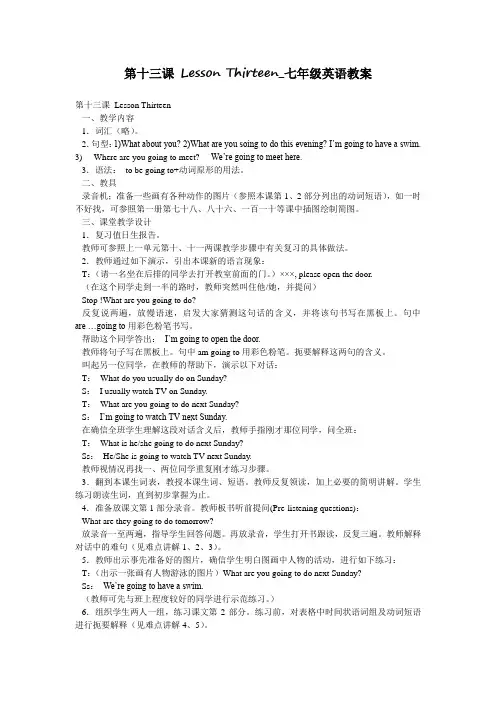
第十三课 Lesson Thirteen_七年级英语教案第十三课Lesson Thirteen一、教学内容1.词汇(略)。
2.句型:1)What about you? 2)What are you soing to do this evening? I’m going to have a swim.3)----Where are you going to meet?----We’re going to meet here.3.语法:to be going to+动词原形的用法。
二、教具录音机;准备一些画有各种动作的图片(参照本课第1、2部分列出的动词短语),如一时不好找,可参照第一册第七十八、八十六、一百一十等课中插图绘制简图。
三、课堂教学设计1.复习值日生报告。
教师可参照上一单元第十、十一两课教学步骤中有关复习的具体做法。
2.教师通过如下演示,引出本课新的语言现象:T:(请一名坐在后排的同学去打开教室前面的门。
)×××, please open the door.(在这个同学走到一半的路时,教师突然叫住他/她,并提问)Stop !What are you going to do?反复说两遍,放慢语速,启发大家猜测这句话的含义,并将该句书写在黑板上。
句中are …going to用彩色粉笔书写。
帮助这个同学答出:I’m going to open the door.教师将句子写在黑板上。
句中am going to用彩色粉笔。
扼要解释这两句的含义。
叫起另一位同学,在教师的帮助下,演示以下对话:T:What do you usually do on Sunday?S:I usually watch TV on Sunday.T:What are you going to do next Sunday?S:I’m going to watch TV next Sunday.在确信全班学生理解这段对话含义后,教师手指刚才那位同学,问全班:T:What is he/she going to do next Sunday?Ss:He/She is going to watch TV next Sunday.教师视情况再找一、两位同学重复刚才练习步骤。
七年级上册 Unit 13 教案
Millie have a dog?Yes.
’s the name of the dog?Eddie.
Simon like football?Yes.
Sandy tall and slim?Yes.
does Sandy like?Music.
wears glasses, Simon or Daniel?Daniel
4)鲍勃的表哥在校篮球队.(Bob’s cousin is in the school basketball team.)
5)他的同桌是从哪里来的?她从上海来. (Where is his deskmate from?/Where does his deskmate come from?She is /comes from Shanghai.)
课题
七年级(英语)上册Unit 1 This is meReading (Ⅱ)
总第3课时
三维
教学
目标
1.知识目标
1)词汇:能够运用本课的四会单词。
2)词组:…years old; love reading; play football ;after school; like music; be from Nanjing
4.有关句型的练习:Fill in the blanks with the correct form of the words.
1) She likes _________ (read) books on Sundays. (reading)
2) The boy loves ________ (play) football after school. (playing)
Step II练习
新人教版七年级英语上册《StarterUnit13》导学案.doc
课题学习目标学习过程课预习展示型1.会说会默写会运用本课单词2.会说会写会运用关于见面时问候的句型:A:Howareyou?B:I’mfine,thanks.Howareyou?(Andyou)B:I'mOK.Step1.自主学习自主认真完成任务一至任务四,然后进行对学群学。
任务一:认真书写记忆以下单词。
〔对子组互查互考〕1.怎样_________________2。
是___________________3.你,你们_________________4.我_________________5.是________________________6.好的___________________7.谢谢___________________8.好,不错____________________任务二:大声朗读以下对话,并编写出自己的对话。
A:Goodafternoon,Dale!B:Hi,Cindy! Howareyou?I’mfine,thanks.Howareyou?(Andyou?)B:I'mOk.〔I’mfine,too.〕_我的新对话A:__________________________________________B:___________________________________________A:____________________________________________B:____________________________________________任务三:按要求写出以下单词1.yes(反义词)____________2thankyou( 同义词)______________3.R( 同音词)________ 4.see(同音字母大小写)_____________am( 缩写形式 )_______________任务四:根据汉语完成句子。
七年级英语上册 Starter Units 13教案 (新版)人教新目标版
Starter Unit 1 Good morning!The First Period(1a-2e)Ⅰ.Teaching aims:1.Knowledge aims:(1)Key letters:Aa,Bb,Cc,Dd,Ee,Ff,Gg,Hh(2)Key words:good,morning,hi,hello,HB,CD,BBC(3)Key phrases:Good morning!(4)Important sentences:①—Good morning,Helen!—Good morning,Bob!②—Hello,Eric!—Hi,Frank!2.Ability aims:Make students learn some good manners when meeting.3.Emotion aims:Motivate students’ interest in learning English.II.Important points:Grasp some greeting sentences and letters from Aa to Hh.III.Difficult points:Read English names and write letters correctly.IV.Teaching processStep 1 Lead-inListen to a “ABC Song”.Then students learn to sing this song.Step 2 Presentation1.Greet the class with a smile and say “Good morning!”.Introduce the words “teacher”and“class”by using gestures.2.Introduce yourself and say“I’m Miss/Mr. ...”Repeat them several times.Explain the terms“Miss”and “Mr.”in Chinese.3.Leave the classroom,return and say“Good morning,class!”Help the students respond with“goodmorning,Miss/Mr. ...”Say“Sit down,please.Now let’s start the lesson.”(Practice it several times.)Step 3 Game:Choose an English nameWork on 1a.Look at the screen.Show students some pictures.There are some boys and girls in it.They are fromthe USA and England.Do you know them?Write down their names in your book.Divide them intwo groups.Girls’ names and boys’ name.Step 4 ListeningWork on 1b.1.Tell students that our new friends are greeting each other.Please keep quiet and listen to therecording.2.Students listen and repeat after the recording.Step 5 PairworkWork on 1c.S1:Good morning,Cindy!S2:Good morning,Grace!S3:Hello,Frank!S4:Hi,Bob!Step 6 ListeningWork on 2a-2b.Introduce English letters Aa~Hh.Teach students to read and write them correctly. According to recording and work on 2b.Step 7 Writing1.First,look at the picture carefully in 2c.Then tell us how to write these English letters.2.Students read and find out the writing rules of the letters Aa~Hh.3.Students try to copy the letters by themselves.4.Let some students come to the front,and write down the letters on the blackboard.Check theanswers with the class.Step 8 PracticeWork on 2d.Ask students to write down the missing letters in their books.Check the answers with the class.Step 9 Read and TalkLet students talk about the meaning of each picture.HB(铅笔芯)硬黑 CD光盘;激光唱片 BBC英国广播公司Language points1.“Good morning!”是早上见面的常用问候语,多用于熟悉的人之间。
初中七年级英语教案Lesson 13 How Is School Going-名师
Lesson13: How Is School GoingⅠ.Teaching aims:learn to use the adverbs of frequency:usually, always, often2. To learn some key words and usefulexpressionsⅠ.Teaching important and difficult points::How is……going be good at, by oneself, sports meet, twice a year.:Adverbs: always; often; usually;Ⅰ.Moral aims: Encourage students to love the campus life, and learn to care for others and to help others in life.Ⅰ.Teaching methods: Listening; speaking and reading.Ⅰ.Teaching times :1 class timeⅠ.Teaching procedures :Say hello to students.(3’)1.Dictation the words.2.Check the homework.(6’)life n. 生活. term n. 学期. start v. 开始;出发. finish v. 完成结束. twice adv. 两次;两倍. win v. 赢得;获胜. yeah int.(口语)是;对. social adj. 社会的. shopn. 手工艺课.myselfpron. 我自己.(3’)do you start school every day2.How many lessons do you have(20’)A.Read the lesson and answer the question.1.How is Jenny’s school life going2.How many classes does Wang Mei have every day3.What is Wang Mei’s favourite subject4.What is Jenny’s favourite subject5.What did Jenny make in shop class last weeknguage points.1.句中的usually, always,always ,never和often叫做频度副词。
- 1、下载文档前请自行甄别文档内容的完整性,平台不提供额外的编辑、内容补充、找答案等附加服务。
- 2、"仅部分预览"的文档,不可在线预览部分如存在完整性等问题,可反馈申请退款(可完整预览的文档不适用该条件!)。
- 3、如文档侵犯您的权益,请联系客服反馈,我们会尽快为您处理(人工客服工作时间:9:00-18:30)。
Unit 13 What colour is it?
一、教学目标与要求
通过本单元教学,使学生能运用所学英语,正确地描述物体的颜色;同时进一步学习分辨人物的用语,并加以运用。
VFf在本单元还要继续认读6个国际音标。
二、教学重点与难点
1、句型:1)What colour is it?It's red /blue/black...2)What colour are they? They're red/blue/black...
2、语法:初步学习不定代词one的用法。
3、音标:认读[U:],[Q],[h],[r],[j],[w]等音标。
三、课时安排
本单元共4课时,每课1课时。
第四十九课
一、教学内容
1、词汇(略)
2、句型:What colour is it ? It's red/black...
二、教具
录音机;一大张白纸和各种颜色的彩笔。
三、课堂教学设计
1、值日生报告。
2、将事先准备好的白纸挂在黑板上,用红色彩笔画一辆小汽车简图,向学生提问:
T: What's this in English?
Ss It's a car.
T: What colour is it?
教师自己回答:It's red.
启发学生猜这两句的意思。
然后再用黑色彩笔画另一辆小汽车,重复刚才的步骤。
3、教师借助自己手中的彩笔(或彩色插图第页的彩色方块),教授其他颜色的名称,反复来读这些单词,直到学生初步掌握为止。
4、打开书,学生看图。
放课文第一段录音,学生先听,然后跟读两至三遍。
5、教师在白纸上画几个其他物体(用不同颜色彩笔),挂在黑板上。
指导学生两人一组,依照课文第一部分进行问答(对话中的on the hill可以改为on the blackboard)。
请几组表演。
6、两人一组,就课文第二部分进行回答。
7、指导学生做练习册习题。
8、布置作业
1)抄写生词;2)完成练习册习题
第五十课Lesson Fifty
一、教学内容
1、词汇(略)
2、初步学习不定代词one的用法
二、教具
录音机;上节课使用过的图片。
三、课堂教学设计
1、复习上一课所学的单词和句型。
先放一遍第49课第1段录音,然后指导学生就挂在黑板上的图画进行问答练习。
2、请3个男学生(注意要挑穿不同颜色衣服的)到前面去,然后问全班:T: Excuse me ,who is that boy?
全班同学自然不知道老师指的是谁。
教师帮助学生们说出:Which boy?
T:The one in the green coat.
帮助学生答出:Oh,that's...
教师再叫3个女学生,重复刚才的步骤。
3、打开课本,学生看图。
教师先对4联幅画中人物用以下句子提问:
T:What can you see in Picture1(2,3,4)?Where is the man(the boy, the girl)?What colour is that woman's coat?
学生回答教师提出的问题,并做好学习课文的心理准备。
4、放课文录音。
每张图片对应的内容可放两遍。
学生看书并跟读,整个对话学生要读两至三遍。
5、合上书。
教师重复第2个步骤。
但这次要求学生能熟练答出。
(扼要解释的用法)
6、指导学生做练习册习题。
7、布置作业
1)抄写生词;2)练习朗读本课对话;3)完成练习册习题。
四、难点讲解
1、A:Which man?哪个人?
B:The one in a whi te car.坐在一辆白色小汽车里的那个人。
one在本句中不表示“一”,而是代词,代替上文提到的man,主要是避免重复。
例如:A:Look at the picture!看那张图片!
B:Which one?哪一张?
A:The one on the teacher's desk.在老师讲台上的那一张。
B:Oh, it'sa nice one.噢,真是一张不错的画。
e here!到这里来。
这是一个祈使句。
在使用动词come和go时,要注意它们之间有着方向性的区别。
come 是“来”的意思,即动作朝着说话者的方向;go是“去”的意思,动作的方向截然相反。
副词here表示“这里”,因此它只能在后面使用;there是“那里”的意思,用在go 的后面。
第五十一课
一、教学内容
1、词汇(略)。
2、句型:复习前两课学过的句型。
二、教具
录音机。
三、课堂教学设计
1、复习上一课所学的词汇及句型。
放一遍第50课录音,学生跟读。
重复做第49课教案中
的步骤2、5。
但这次要求学生提问、应答。
2、两人一组,做第50课练习册习题3 。
分别叫4组同学在班上表演自己的小对话。
3、教sweater这个单词。
放课文第一部分录音。
先板书如下问题:
1)What are in the boxes? 2)What colour are they?
放录音,一至两遍。
学生回答黑板上的问题。
再放录音,学生跟读两至三遍。
4、两人一组,就课文第二部分的6张图画进行问答练习。
请6组同学表演自己的小对话。
5、放课文第三部分录音,做听力练习。
先给学生两分钟时间过一遍练习册习题1的内容。
6、指导学生做练习册其他习题。
7、布置作业
1)练习朗读本课对话;2)完成练习册习题。
四、难点讲解
Can't you see?你(难道)看不见吗?
这是一般问句的否定形式,简称否定问句。
这种疑问句表示说话人的一种思想感情,而不是仅仅在于提出一个什么问题。
本课出现的这个问句就是这样一种情况。
其背景是:某同学抱着一大摞盒子从商店出来,同学上去问:
A:What are these?这些是什么呀?
同学B回答:Can't you see?They 're boxes. 你看不见吗?是盒子呀。
他在讲这句话时,语气中流露出惊奇,包含有:“难道你自己没看见它们是盒子”的意思。
否定疑问句的构成是在一般疑问句的主语之后,加上not。
但在实际应用中,都采用not的缩写形式。
这时,该缩写形式提到主语的前面,与句首的动词连在一起使用。
请比较以下例句:
Are you not a student?你不是学生?
Aren't you a student?
Can he not do it?
Can't he do it?他不能做那件事吗?
在回答这种否定疑问句时,要按照实际情况来决定是用Yes还是用No来应答,这和汉语是有区别的。
例如:
A: Isn't he here?他不在这儿吗?
B: No,he isn't.对,他不在。
A: Can't he see the picture?他看不见那张画?
B: Yes,he can.不,他看得见。
第五十二课
一、教学内容
1、单元复习
2、认读[U:],[Q],[h],[r],[j],[w]等音标。
3、小结本单元表示颜色的句型。
二、教具
录音机;音标卡片。
三、课堂教学设计
1、复习。
指导学生两人一组,利用第二部分的6张插图,模仿第一部分内容,编一个小对
话。
例如:(Picture 1)
S1: What are these?
S2:Can't you see? They're kites.
S1:What colour are the kites?
S2:They're red.
如学生开始有困难,教师可先做示范。
必要的话,重放第51课第一段录音,学生先跟读一至两遍,再编小对话练习。
请几组同学表演自己的小对话.
2、检查第51课习题,对练习题中学生们遇到的问题进行讲解。
3、放课文第二段录音,要求学生准备彩笔,按录音要求将6幅插图涂上适当的颜色(也可以叫学生回家后再做这项工作)。
4、教师出示音标卡片。
先复习在前面认读过的24个音标。
教学生认读本课出现的音标,并放录音(参照第36、第40课教案)。
练习朗读练习册习题1。
5、指导学生自己过一遍复习要点(13)。
解答学生提出的疑问。
小结本单元中表示颜色的句型及用法。
6、指导学生做练习册其他习题。
7、布置作业
1)朗读所学音标及例词;2)完成练习册上习题。
8、小测验
1)听写本单元中要求四会的单词及表示颜色的主要句型;2)教师准备一些包括有元音字母a,e,i,o,u的单词(每个字母有两种不同读音出现)要求学生标出元音字母的音标;3)从第50课、第51课中各选出一幅插图,要求学生用所学句型看图写话。
